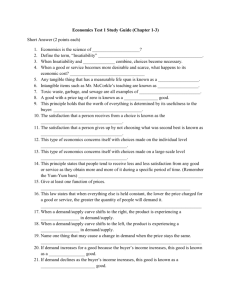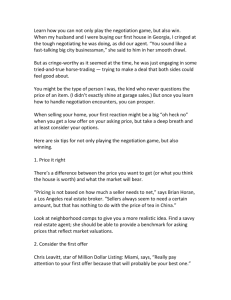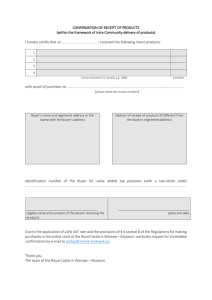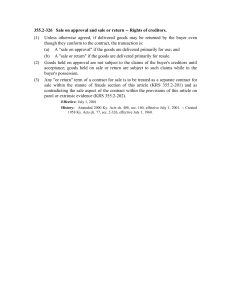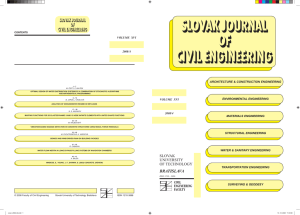international negotiation * ucl, january 2014
advertisement
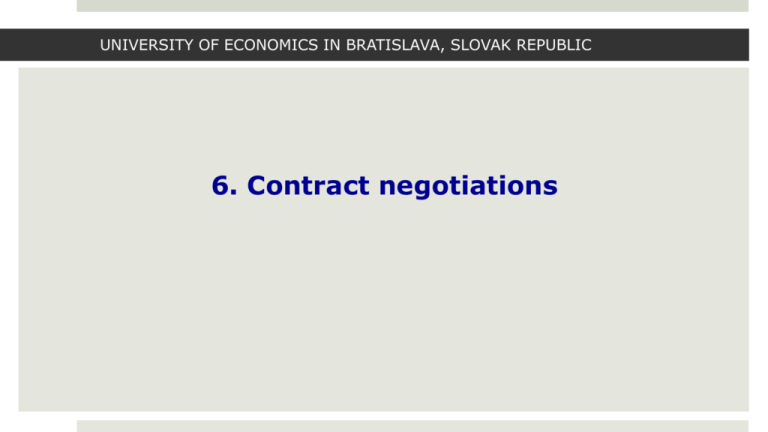
UNIVERSITY OF ECONOMICS IN BRATISLAVA, SLOVAK REPUBLIC 6. Contract negotiations UNIVERSITY OF ECONOMICS IN BRATISLAVA, SLOVAK REPUBLIC Negotiators as representatives Conditions that Prevent Spontaneous Response When there is little latitude in determining their position or posture Negotiation team When they are held accountable for their performance When they have sole responsibility Purchasing items units When they are responsible to a constituency present in the negotiations When they are appointed rather than elected The Buyer’s Negotiation Position will be Strong If: Demand is not urgent Suppliers are keen for the business Buyer is in a monopolistic or semi position Demand can be met by alternatives/substitutes Make and buy options are available Buyer has a reputation for fair dealing Strong supplier position: Demand is urgent Suppliers are indifferent accepting business Monopolistic or semimonopolistic Strong reputation of quality, reliability Supplier owns necessary tools or specialised machinery Buyer has excellent supply market intelligence Supplier is well informed about buyer position UNIVERSITY OF ECONOMICS IN BRATISLAVA, SLOVAK REPUBLIC Stages of a Negotiation List of topics + timing Introductions, agenda agreement and rules of procedure Ascertaining the negotiation range Agreement of common goals Identification and removal of barriers Agreement and closure Openness saves time (collaborative approach) Problem solving Considerations of solutions.... Determination of concessions..... Some ‘personnel’ factors in negotiation UNIVERSITY OF ECONOMICS IN BRATISLAVA, SLOVAK REPUBLIC 7. Capital investment purchases Definition One of the subclasses of the fixed asset category and includes industrial and office machinery and tools, transportation equipment, furniture and fixtures and others. As such, these items are properly chargeable to a capital account rather than to expense. Categories of Capital Equipment Buildings Installation equipment Accessory equipment Operating equipment Tools and instruments Furnishings and fittings How Capital Equipment Procurement Differs from that on Materials and Components Cost per item is usually greater The equipment facilitates production Financed with long-term capital Tax considerations play a big part in the decision Government financial assistance may be available The purchase may be postponable Decision to purchase, results in consequences for sale, output and labour Factors to Consider When Buying Capital Equipment Purpose Flexibility Spares Standardisation Compatibility and existing equipment Life Reliability Durability Product quality Cost of operation Cost of installation Cost of maintenance Miscellaneous, e.g., space requirements Leasing – Advantages and Disadvantages Advantages Disadvantages • Costs are known in advance • Fixed obligation to pay • Does not provide the prestige or flexibility of ownership • Large organisations may obtain capital or equal terms with lessors • Flexibility to dispose of obsolete equipment before end of lease may be reduced • Reduced need to tie up capital in fixed assets • Concerned only with rentals • Hedge against risk of obsolescence Capital Investment Purchases – The Buyer’s Contribution Provide a gateway for commercial considerations Influence the specification to avoid single source quotations Emphasise life-cycle costs Prepare comprehensive invitations to tender Provide commercial, contractual and negotiating expertise Research alternatives to the purchase of new machines Identify government grants that may be available Research international market Assist with disposal of displaced asset
